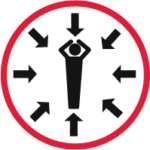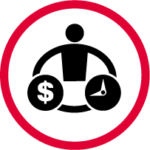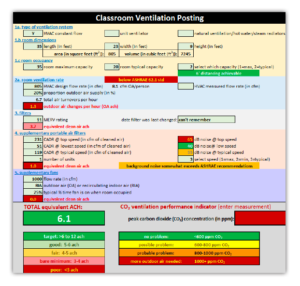Work Demands



Do you or your workers constantly feel that you don't have enough time or that you have to work at a high pace just to get your work finished?
Does your job require doing work that involves emotional issues? If so, the following resources can help:
Quantitative Demands deal with how much one has to achieve in ones work. Quantitative demands can be assessed as a incongruitty between the amount of tasks and the time available to perform these tasks in a satisfactory manner.
IDEAS for ACTION
- Set clear guidelines that balance the quantity and quality of work
- Distribute tasks in relation to their difficulty and time demands
- Clearly prioritize tasks, and include the possibility of postponing some tasks
- Get workers’ input on the planning, prioritization and performance of their work
- Co-ordinate between teams to increase effectiveness
- Reduce or eliminate unproductive tasks such as control operations, writing reports, filling in forms or administration
- Reduce interruptions that break worker concentration and interfere with tasks
Source: Canadian Centre for Occupational Health and Safety (CCOHS)
ILO CHECKPOINT 6
Adjust the total workload taking into account the number and capacity of workers.
WHY
- Good performance and well-being depend on a workload adjusted to individual workers within a team. Good managers know the types and demands of the work their workers are performing.
- Overloaded workers experience fatigue, loss of concentration, a feeling of being overwhelmed, and stress.
- Be careful: workload is not only a question of quantity or physical demand. It is also a qualitative matter of concentration, vigilance, overlapping of tasks, human relations and so forth.
- Undue workload means being overloaded, lacking sufficient time to do the job or having to work too fast, for example, by setting aside the quality of the work and having no chance to recuperate.
- Realistic adjustment of workload thus maintains good performance and leads to customer satisfaction.
HOW
- Assess individual and team workloads through observation and discussion with workers to determine whether change is necessary and feasible.
- Adjust the amount of work per worker to avoid any worker being overloaded. Work should be able to be performed without difficulty and to quality standards within the deadline. Take into account individual differences and adjust workloads accordingly.
- Add workers when and where it is necessary.
- Reduce unnecessary tasks such as control operations, writing reports, filling in forms or registration work. These activities have a significant impact on workers’ concentration. Instruct workers about the correct use of their tools. Have them ask for repair or replacement when tools are damaged or worn out.
- Reduce ineffective interruptions which break workers’ concentration and interfere with production or service objectives.
- Change the work process to facilitate the completion of work requirements, for example, by reviewing the distribution of tasks or using innovative approaches and technology.
SOME MORE HINTS
- Improve working conditions and work organization to fully utilize the capacities of workers.
- Train workers to develop their competencies and skills
- Plan appropriate deadlines to achieve better distribution of the workload in a reasonable period of time.
- Encourage regular discussions about workload between supervisors and workers.
- Plan, review and adjust present and future workload levels to increase performance and maintain a healthy workforce.
POINTS TO REMEMBER
Adjust the workloads of individual workers. Appropriate workloads help improve workers’ performance and health.

Figure 6a. Adjust the amount of work per worker to avoid any worker being overloaded. Improve workstations and workflow from ergonomic points of view.

Figure 6b. Allocate work to a group of workers so that the work load is shared by good teamwork.
GET THE APP | VIEW PDF | DOWNLOAD PDF
Source: International Labour Office (ILO)
ILO CHECKPOINT 7
Rearrange work assignment to prevent excessive demands on workers.
WHY
-
When various workers do not have the same amount of work (some being overloaded and others under-utilized), there is a problem of unbalanced distribution of work.
-
If the distribution of work is unequal and unfair, there is a risk of exhausting your best workers and under-stimulating the others. Productivity may decline.
-
Good distribution of workloads has a positive impact on productivity and workers’ well-being.
-
Workers will have higher motivation to do good work if the work is distributed equally and fairly.
HOW
-
Observe the work being done, talk to the workers to determine whether work is equally and fairly distributed and, if some workers are overloaded or have tasks which are too difficult, find solutions.
-
Take into consideration that some workers may have tasks that are too easy or have too little challenge in their work.
-
Revise job assignment to ensure that workers receive an equitable amount of work, taking into account individual workers’ capacities.
-
Rotate difficult and challenging work amongco-workers.
-
Improve work methods or equipment for overloaded workers, and relieve their workload.
-
Involve workers in group discussion when redesigning work assignment. This is good practice for finding efficient and durable solutions.
SOME MORE HINTS
- Remember that workers are individuals with different capacities and health conditions, so it is appropriate, in some situations, for work to be not equally, but fairly, distributed.
- Maintain confidentiality concerning workers’ health issues.
- Protect the health of the unborn child by avoiding work overload for pregnant women.
- Balanced work assignment is a good way to improve and develop workers’ skills and performance.
POINTS TO REMEMBER
Good distribution of work should be part of management practice because it will promote the well-being and productivity of workers.

Figure 7a. Observe the work being done and discuss with workers how to share difficult tasks and avoid overload on particular individuals.

Figure 7b. Involve workers in improving difficult or uninteresting tasks to make it easier to assign tasks, rotate workers and make effective workplans.
GET THE APP | VIEW PDF | DOWNLOAD PDF
Source: International Labour Office (ILO)
ILO CHECKPOINTS
STRESS PREVENTION AT WORK CHECKPOINTS – CHECKPOINT 6
Adjust the total workload taking into account the number and capacity of workers.
GET THE APP | VIEW PDF | DOWNLOAD PDF
Source: International Labour Office (ILO)
STRESS PREVENTION AT WORK CHECKPOINTS – CHECKPOINT 7
Rearrange work assignment to prevent excessive demands on workers.
Source: International Labour Office (ILO)
FACTSHEETS
JOB BURNOUT
Source: Canadian Centre for Occupational Health and Safety (CCOHS)
ADDRESSING CONFLICTS
Source: Canadian Centre for Occupational Health and Safety (CCOHS)
HAVING COURAGEOUS CONVERSATIONS
Source: Canadian Centre for Occupational Health and Safety (CCOHS)
PODCASTS
A MENTALLY HEALTHY WORKPLACE
Source: CCOHS
PEER-TO-PEER SUPPORT and MENTAL HEALTH IN THE WORKPLACE: An Interview with Steve Tizzard
Source: Canadian Centre for Occupational Health and Safety (CCOHS)
SOCIALLY BRIDGE THE PHYSICAL DISTANCE
Source: Canadian Centre for Occupational Health and Safety (CCOHS)
SUPPORTING MENTAL HEALTH IN THE WORKPLACE
Source: Canadian Centre for Occupational Health and Safety (CCOHS)
Work pace means having to work at a high pace to get your work done.
ILO CHECKPOINTS
Title
Source:
Title
Source:
IDEAS for ACTION
Ideas for managing the pace of work:
- Jointly define reasonable workloads and set adequate staffing levels at all times
- Schedule work to avoid deadlines which are too short or grouped together
- Include a buffer of time between tasks in a fast-paced work environment
- Ensure breaks are taken, and encourage workers to leave the building at lunch
- Establish clear expectations for responsibilities and performance goals
- Set clear guidelines that balance the quantity and quality of work
- Clearly prioritize tasks, and include the possibility of postponing some tasks
Source: Canadian Centre for Occupational Health and Safety (CCOHS)
FACTSHEETS
Title
Source:
Title
Source:
PODCASTS
Title
Source:
Title
Source:
Emotional Demands refers to ......
IDEAS for ACTION
Ideas for managing emotionally challenging work:
- Set specific work objectives and outcome goals that defines success and when work is considered good enough
- Encourage feedback, discussions, and support from peers and supervisors
- Consider having a place for privacy and withdrawal after intense emotional encounters
- Provide education and training appropriate for servicing customers, patients, and clients with special needs
- Ensure breaks are taken, and encourage workers to leave the building at lunch
- Establish critical response and debriefing procedures
- Establish communication procedures between shifts and between persons with responsibility for the same customer, patient, or client
Source: Canadian Centre for Occupational Health and Safety (CCOHS)
ILO CHECKPOINTS
TITLE
Source:
TITLE
Source:
FACTSHEETS
TITLE
Source:
TITLE
Source:
TITLE
Source:
TITLE
Source:
TITLE
Source:
PODCASTS
TITLE
Source:
TITLE
Source:
TITLE
Source:
TITLE
Source:

